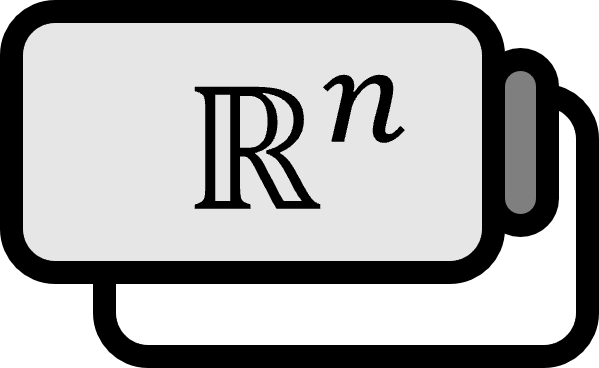Volume in Vector Fields
Definition
The volume $V$ of a subspace $D \subset \mathbb{R}^{n}$ in a Euclidean space is defined as follows when expressed in Cartesian coordinates $\textbf{u} = (u_{1}, u_{2}, \cdots , u_{n})$.
$$ V(D) = \int_{D} du_{1} du_{2} \cdots d u_{n} $$
When $\textbf{u} \in \mathbb{R}^{n}$ is transformed by a vector function $\textbf{f} : \mathbb{R}^{n} \to \mathbb{R}^{n}$ as $\textbf{f} \left( \textbf{u} \right) = \left( f_{1} (\textbf{u}) , \cdots , f_{n} (\textbf{u}) \right)$, the volume of $D$ is as follows.
$\displaystyle \left| {{ \partial \textbf{f} (\textbf{u}) } \over { \partial \textbf{u} }} \right|$ represents the determinant of the Jacobian matrix of $\textbf{f} (\textbf{u})$, as can be shown. $$ \left| {{ \partial \textbf{f} (\textbf{u}) } \over { \partial \textbf{u} }} \right| = \det \begin{bmatrix} {{\partial f_{1} (\textbf{u}) } \over {\partial u_{1} }} & \cdots & {{\partial f_{1} (\textbf{u}) } \over {\partial u_{n} }} \\ \vdots & \ddots & \vdots \\ {{\partial f_{n} (\textbf{u}) } \over {\partial u_{1} }} & \cdots & {{\partial f_{n} (\textbf{u}) } \over {\partial u_{n} }} \end{bmatrix} $$
Explanation
Some might feel intimidated just by seeing $\displaystyle V(D) = \int_{D} \left| {{ \partial \textbf{f} (\textbf{u}) } \over { \partial \textbf{u} }} \right| d u_{1} \cdots d u_{n}$. However, this post is meant to explain and make it easy to understand, so calmly read the explanation below.
Volume generalizes the concept of length in $1$ dimensions, area in $2$ dimensions, and volume in $3$ dimensions to $n \in \mathbb{N}$ dimensions. In Korea, volume is typically translated to ‘volume’ in English, but in mathematics, these concepts are not distinctly categorized, hence using the term [volume] as it is pronounced, might evoke the concept of $n=3$ dimensions due to generalization.
Coordinate Transformation
The vector function $\textbf{f}$ can have various applications depending on the field, but if thought of in the context of physics, it can be considered as a transformation of coordinate systems. For instance, if $\textbf{f}$ is given as follows:
$$ \begin{align*} \textbf{f} (r,\theta) =& \left( f_{1} (r,\theta) , f_{2} (r,\theta) \right) \\ =& \left( x (r,\theta) , y (r,\theta) \right) \\ =& (r \cos \theta , r \sin \theta) \end{align*} $$
This becomes the polar coordinate system. Eliminating $\textbf{f}$ and converting $x = x (r,\theta)$ and $y = y (r,\theta)$ into expressions familiar to us:
$$ x = r \cos \theta \\ y = r \sin \theta $$
The determinant of this Jacobian matrix is:
$$ \begin{align*} \det \begin{bmatrix} {{\partial x } \over {\partial r }} & {{\partial x } \over {\partial \theta }} \\ {{\partial y } \over {\partial r }} & {{\partial y } \over {\partial \theta }} \end{bmatrix} =& \det \begin{bmatrix} \cos \theta & \sin \theta \\ -r \sin \theta & r \cos \theta \end{bmatrix} \\ =& r \cos^{2} \theta + r \sin^{2} \theta \\ =& r \end{align*} $$
Therefore, the area (volume) $V(R)$ of the given region $R \subset \mathbb{R}^{2}$ in $2$ dimensions is calculated as follows:
$$ V(R) = \int_{R} r dr d\theta $$
It is important not to confuse that $\textbf{f}$ does not map $(x,y)$ to $(r,\theta)$; instead, we used the point $(r, \theta)$ in the polar coordinate system to represent the point $(x,y)$ in the Cartesian coordinate system, meaning $\textbf{f}$ maps $(r, \theta)$ to $(x,y)$.
Why is $V$ Defined That Way
To explain why the volume $V$ is defined in such a way, it’s better to look at the process of how volume is derived. Let’s start with the infinitesimal volume. Generally, in dimensions lower than $3$, the following $dx, dA, dV$ are sequentially called infinitesimal length, infinitesimal area, and infinitesimal volume.
$$ \begin{align*} dx =& dx \\ dA =& dxdy \\ dV =& dxdydz \end{align*} $$
Just as the length of the $1$ dimensional interval $I = [x_{1},x_{2}]$ can be calculated as:
$$ (x_{2} - x_{1}) = \int_{x_{1}}^{x_{2}} dx = \int_{I} dx $$
the area of a $2$ dimensional rectangle $R = [x_{1}, x_{2}] \times [y_{1} , y_{2}]$ is:
$$ (x_{2} - x_{1}) (y_{2} - y_{1}) = \int_{y_{1}}^{y_{2}} \int_{x_{1}}^{x_{2}} dxdy = \int_{R} dA $$
and the volume of a $3$ dimensional rectangular parallelepiped $D = [x_{1}, x_{2}] \times [y_{1} , y_{2}] \times [z_{1} , z_{2}]$ is:
$$ (x_{2} - x_{1}) (y_{2} - y_{1}) (z_{2} - z_{1}) = \int_{z_{1}}^{z_{2}} \int_{y_{1}}^{y_{2}} \int_{x_{1}}^{x_{2}} dxdydz = \int_{D} dV $$
When generalizing the process of calculating volume in Cartesian coordinates, the infinitesimal volume
$$ dV = d u_{1} d u_{2} \cdots d u_{n} $$
and applying the definite integral $\displaystyle \int_{D}$ to both sides of the equation, one can accept the following expression: $$ \int_{D} d u_{1} d u_{2} \cdots d u_{n} = \int_{D} dV = V(D) $$
Here, $D$ doesn’t need to necessarily be the Cartesian product of closed intervals, and its shape could be round, star-shaped, or anything else. However, the actual calculation might be challenging, and that’s when coordinate transformation comes handy, making such mathematical formulations easier to handle.
